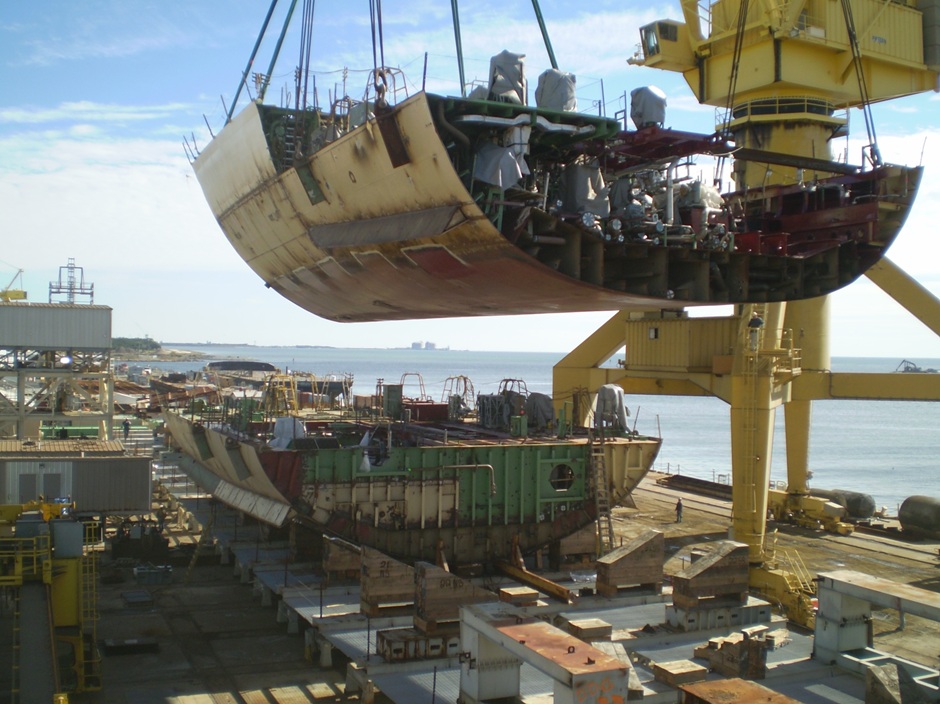DoD 2020 Budget Looks to Fix Shipbuilding, Ammo Industrial Base
Posted on

The USS Finn under construction in Pascagoula, Miss.
PENTAGON: The Defense Department plans to pump $286 million into parts of the defense industrial base identified as at risk by a major White House report released late last year. The investments aim to boost everything from large shipyards to tiny suppliers of ammunition components.
Budget documents released last week for fiscal 2020 fail to spell out exactly where that money will go. But Pentagon spokesperson Lt. Col. Mike Andrews told me that the money will support “a number of areas in the industrial base – such as shipbuilding and munitions – to increase readiness and ensure robust capabilities as we address the near-peer threats outlined in the National Defense Strategy.”
There are plenty of concerns about the health of the manufacturing sectors both in shipbuilding and ammo production, albeit for very different reasons.
On the Navy side, the service currently faces a massive backlog in shipyard availabilities and that means slow repair times. A whopping 70 percent of the service’s destroyers can’t make it out of the shipyard on time when they come in for repairs. That has more than operational impacts. If the Navy ever hopes to reach its goal of a 355-ship fleet, it will have to extend the lives of dozens of ships already nearing the end of their lifespans — and do so at a time when shipyard space is already stretched.
The Navy is looking to make more and better use of both public and private shipyards to do maintenance work, Vice Adm. Tom Moore, head of Naval Sea Systems Command, told the West 2019 conference last month. “Industry has got to hire more,” Moore said. “We got to build a system that incentivizes industry to have the right people there, so I think you’re going to see a real sea change in the way we’re working to acquire repair work.”
Over the past two decades, the workforce and capacity of the entire defense industrial base in the United States has shrunk, the report stated, shedding more than 20,500 U.S.-based manufacturing firms. As these mostly small companies shuttered their doors, some of that domestic work was sent overseas, leading to a situation where “a surprising level of foreign dependence on competitor nations exists.”
An example of the at-times brittle nature of the industrial base was highlighted by the fact that the Navy currently contracts with just one company to make and repair propeller shafts used by both surface ships and submarines.
Because of the fact that only one shop exists, technical schools have stopped training prospective skilled workers to operate the older machinery used by that company. “If the forge is not modernized, the facility may exit the market, causing disruptions to multiple Navy programs,” the report states.
The Navy had a startling wakeup call last year, when it discovered flaws in the welding of missile tubes aboard the first of its $128 billion Columbia-class submarines.

Navy depiction of the future USS Columbia nuclear missile submarine.
The Navy’s primary submarine builder, Electric Boat, had contracted out the welding work to BWX Technologies, which subcontracted it to another, smaller company. Due to the lack of submarine work in recent years, some of the welding and inspection skills needed had withered, creating a situation that George Drakeley, the civilian in charge of the Navy’s submarine programs called a “debacle,” late last year. He said fixing the issue is “ramping up is going to be harder than we thought.”
The problem also affects the Royal Navy’s new Dreadnought-class submarines, which use the same Common Missile Compartment as the American Columbia class.
When it comes to ammunition, most of the risk the Pentagon sees is with sub-tier suppliers of things like switches and discrete electronic systems. Many of the parts for rockets and projectiles are only made by a single supplier, or use critical source materials from foreign suppliers that could be compromised in some way, officials worry.
Many of those concerns were spelled out in the annual Industrial Capabilities Report, put out by the Pentagon’s Office of Manufacturing and Industrial Base Policy, last spring. The report found that the industrial base of the munitions sector has been battered by the hot-and-cold nature of munitions procurement over the years, and thinned out by the dearth of new designs being developed.

Army HIMARS trucks launch GMLRS (Guided Multiple Launch Rocket System) missiles
Some smaller parts makers have just dropped out of the segment due to the lack of work, leaving gaps in replacing parts in the supply chain. Other important suppliers are foreign-owned, and many raw materials and computer components are being sourced from China (yes, China).
Overall, the industrial base report, compiled by the White House and Pentagon with plenty of defense industry input, identified 300 areas at risk of atrophy, or where the demise of a single supplier could put weapons programs at risk.
The $286 million ask is a blip in the $718 billion budget request for fiscal 2020, but Pentagon officials last year pledged to start filling in the gaps of those 300 vulnerabilities in this year’s budget request.
Eric Chewning, deputy assistant Defense Secretary for industrial policy, told reporters when the report dropped, “I wouldn’t think of this just as an additional ask for money. We also need to be spending more wisely, This isn’t just an investment fix. There’s also legislative fixes; there’s policy fixes; there’s regulatory fixes.”
Chewning has predicted “about a third” of the 300 issues would be dealt with in this budget, with another third addressed over the next few years. The final third “are things that long term we’re going to have to manage, recognizing that new stuff is going to come in and things are going to pop out as we dynamically manage the industrial base.”
Subscribe to our newsletter
Promotions, new products and sales. Directly to your inbox.
